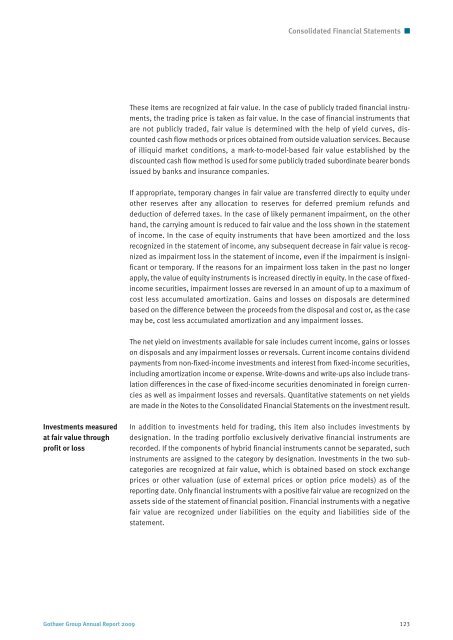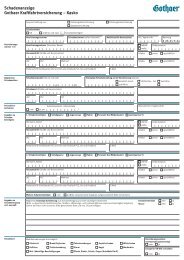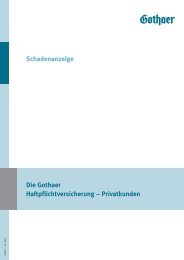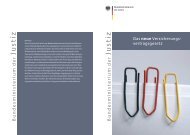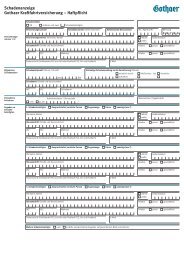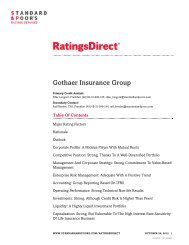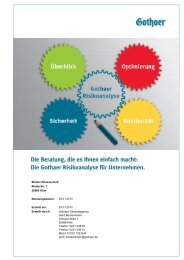01 Gothaer Konzern_E_09_Umschl - Gothaer Allgemeine ...
01 Gothaer Konzern_E_09_Umschl - Gothaer Allgemeine ...
01 Gothaer Konzern_E_09_Umschl - Gothaer Allgemeine ...
You also want an ePaper? Increase the reach of your titles
YUMPU automatically turns print PDFs into web optimized ePapers that Google loves.
Investments measured<br />
at fair value through<br />
profit or loss<br />
Consolidated Financial Statements<br />
These items are recognized at fair value. In the case of publicly traded financial instruments,<br />
the trading price is taken as fair value. In the case of financial instruments that<br />
are not publicly traded, fair value is determined with the help of yield curves, discounted<br />
cash flow methods or prices obtained from outside valuation services. Because<br />
of illiquid market conditions, a mark-to-model-based fair value established by the<br />
discounted cash flow method is used for some publicly traded subordinate bearer bonds<br />
issued by banks and insurance companies.<br />
If appropriate, temporary changes in fair value are transferred directly to equity under<br />
other reserves after any allocation to reserves for deferred premium refunds and<br />
deduction of deferred taxes. In the case of likely permanent impairment, on the other<br />
hand, the carrying amount is reduced to fair value and the loss shown in the statement<br />
of income. In the case of equity instruments that have been amortized and the loss<br />
recognized in the statement of income, any subsequent decrease in fair value is recognized<br />
as impairment loss in the statement of income, even if the impairment is insignificant<br />
or temporary. If the reasons for an impairment loss taken in the past no longer<br />
apply, the value of equity instruments is increased directly in equity. In the case of fixedincome<br />
securities, impairment losses are reversed in an amount of up to a maximum of<br />
cost less accumulated amortization. Gains and losses on disposals are determined<br />
based on the difference between the proceeds from the disposal and cost or, as the case<br />
may be, cost less accumulated amortization and any impairment losses.<br />
The net yield on investments available for sale includes current income, gains or losses<br />
on disposals and any impairment losses or reversals. Current income contains dividend<br />
payments from non-fixed-income investments and interest from fixed-income securities,<br />
including amortization income or expense. Write-downs and write-ups also include translation<br />
differences in the case of fixed-income securities denominated in foreign currencies<br />
as well as impairment losses and reversals. Quantitative statements on net yields<br />
are made in the Notes to the Consolidated Financial Statements on the investment result.<br />
In addition to investments held for trading, this item also includes investments by<br />
designation. In the trading portfolio exclusively derivative financial instruments are<br />
recorded. If the components of hybrid financial instruments cannot be separated, such<br />
instruments are assigned to the category by designation. Investments in the two subcategories<br />
are recognized at fair value, which is obtained based on stock exchange<br />
prices or other valuation (use of external prices or option price models) as of the<br />
reporting date. Only financial instruments with a positive fair value are recognized on the<br />
assets side of the statement of financial position. Financial instruments with a negative<br />
fair value are recognized under liabilities on the equity and liabilities side of the<br />
statement.<br />
<strong>Gothaer</strong> Group Annual Report 20<strong>09</strong> 123


